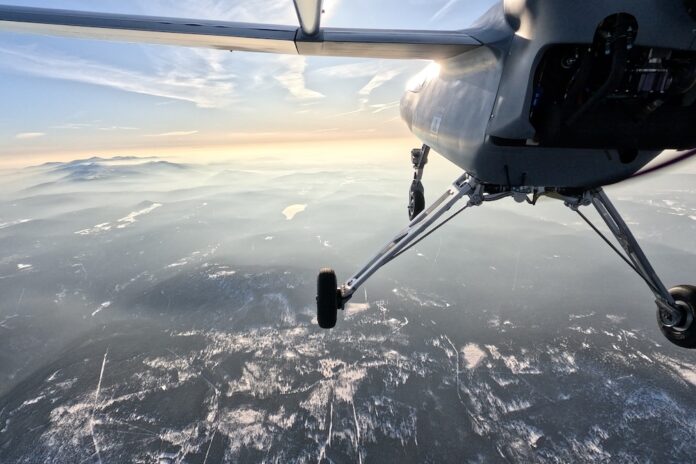While having favourable weather conditions was key, this type of base station will offer new coverage scenarios in emergencies or disasters
In what is describes as the first carrier in Europe to deploy this type of flying base station, Deutsche Telekom has used a Czech drone to provide mobile network coverage to customers on a live commercial network. T-Mobile Czech Republic teamed up with unmanned aviation experts Primoco UAV SE to jointly develop and test the unique solution for temporary mobile coverage. The technology enables the propagation of the mobile signal exclusively through the air — without using a ground transmitter.
During its first deployment the drone provided continuous coverage under favourable weather conditions for four hours to an otherwise uncovered six kilometre stretch of the Jizerská 50 race route, part of Ski Classics, in the Jizera Mountains – all from an altitude odyssey 2.3 kilometres.
The Primoco One 150 drone, which is used as the flying base station, is designed and manufactured in the Czech Republic. The built-in base station can be connected “air-to-ground” to a terrestrial backhaul as well as via satellite “air-to-space”. The system enables download speeds of up to 200 Mbps and upload speeds of 75 Mbps. It can supply up to 1200 users simultaneously. The employed drone is 3.65m long, 1.25m high and has a wingspan of 4.85m.
The drone’s built-in mobile transmitter can be connected to a dedicated local network core to create a stand-alone campus network — for example, for emergency services. However, it can also be connected directly to the live network core via satellite. The drone is operated by a specialist from a control centre, most often from a vehicle due to its movement in the field. The Primoco One 150 drones carry equipment supplied by T-Mobile weighing 8 kg but can carry up to 30 kg and move in operational deployment typically at 1-2 km above the ground.
The drone used by T-Mobile in partnership with Primoco UAV SE has a flight time of up to 15 hours, a flight altitude of up to 3,300 m and a range of up to 1,800km at a cruising speed of 120 km/h. A 10 MHz channel is used for signal transmission, with a speed of up to 90 Mbps. The range of the signal depends on the flight altitude and the frequencies used. Typical coverage is around 9 km2, with a limit of nearly 20 km2
Ideal situation
Jizerská 50 offered an ideal deployment scenario for the flying antenna system, according to DT. The Jizera Mountains Protected Landscape Area is a frequent venue for sporting events and at the same time a nature reserve. Without interfering with the protected area, T-Mobile Czech Republic could ensure the 4,460 participants in the 50-kilometre main race were always connected – reaching download speeds of up to 95 Mbps and an uplink up to 34 Mbps. This year a total of more than 23,600 visitors were on the site.
The new drone solution, which was developed by a T-Mobile Czech Republic innovation team, can be deployed in diverse scenarios. For example, for large sporting events or cultural events in areas with special legal requirements or with inaccessible terrain. These are typically mountainous and densely forested areas or protected areas, where it is not possible to deploy a permanent base station, and even the use of temporary base stations in the form of containers often do not offer an efficient solution.
Another important application scenario is the use of the flying antenna as a flexible alternative in crisis situations – such as floods, earthquakes or fires when the terrestrial infrastructure no longer works. The drone can quickly provide mobile communications for those affected and emergency services.
“In inaccessible terrain or crisis situations, a flying antenna drone provides resilient connectivity. Wherever it is needed. And very effectively. This approach complements Deutsche Telekom’s broad toolbox to reliably provide mobile communications in many scenarios,” said DT board member for technology and Iinnovation Claudia Nemat.
DT said it will be demonstrating one of these drones at Mobile World Congress – presumably outdoors given its size.


